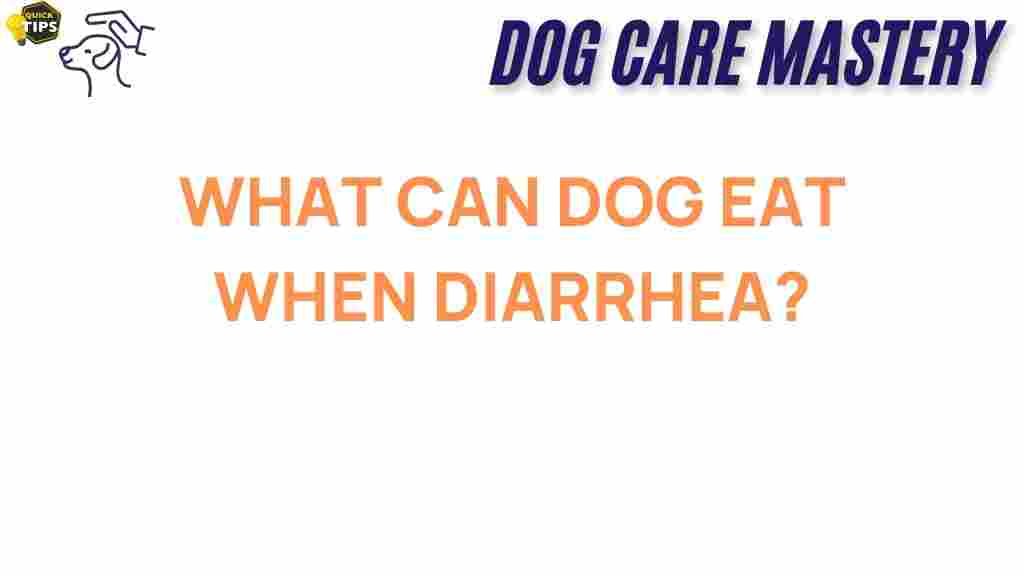What Can Dogs Eat During Diarrhea? Understanding Dog Diarrhea
As a pet owner, it can be distressing to witness your dog suffering from diarrhea. This condition can be caused by various factors, including dietary indiscretion, infections, or underlying health issues. Knowing what your dog can eat during diarrhea is essential for helping them recover quickly and comfortably. In this article, we will explore safe food options, tips for managing dog diarrhea, and when to seek veterinary help.
Understanding Dog Diarrhea
Diarrhea in dogs is characterized by loose or watery stools. It can be acute (short-term) or chronic (long-lasting) and may be accompanied by other symptoms such as vomiting, lethargy, or loss of appetite. Before we delve into the dietary recommendations, let’s discuss the potential causes of dog diarrhea:
- Dietary indiscretion (eating something they shouldn’t)
- Food allergies or intolerances
- Infections (bacterial, viral, or parasitic)
- Stress or anxiety
- Underlying health issues (such as pancreatitis or inflammatory bowel disease)
Identifying the cause of your dog’s diarrhea can help you decide the best course of action and dietary choices.
Step-by-Step Process: What to Feed Your Dog During Diarrhea
When your dog is experiencing diarrhea, it’s crucial to provide them with easily digestible foods that can help firm up their stool. Here’s a step-by-step guide on what you can feed them:
Step 1: Withhold Food for 12-24 Hours
Before introducing any food, it’s often recommended to withhold food for 12-24 hours. This fasting period allows your dog’s digestive system to rest and recover. However, make sure they have access to fresh water to prevent dehydration.
Step 2: Introduce a Bland Diet
Once the fasting period is over, you can gradually introduce a bland diet. Here are some safe options for your dog:
- Boiled chicken (no skin or bones) – Lean protein that is easy to digest.
- White rice – A great source of carbohydrates that can help firm up stools.
- Pumpkin (plain canned or cooked) – Rich in fiber, it can help regulate digestion.
- Boiled potatoes (without skin) – A good source of carbohydrates that are gentle on the stomach.
- Plain yogurt – Contains probiotics that can aid gut health.
Mix these ingredients together in small portions. Start with a small amount (about 1-2 tablespoons) and monitor your dog for any adverse reactions.
Step 3: Gradually Reintroduce Regular Food
After 2-3 days of a bland diet, if your dog’s condition improves, you can start to reintroduce their regular food gradually. Mix a small portion of their regular food with the bland diet, increasing the proportion of regular food over several days.
Foods to Avoid During Dog Diarrhea
While it’s essential to know what to feed your dog during diarrhea, it’s equally important to know what to avoid:
- Fatty foods – High-fat meals can exacerbate diarrhea.
- Dairy products – Many dogs are lactose intolerant, which can worsen diarrhea.
- Spicy foods – Can irritate your dog’s digestive system.
- Processed foods – Often contain additives that can upset a dog’s stomach.
- Raw foods – Can carry bacteria that may worsen gastrointestinal issues.
Hydration is Key
During diarrhea, your dog is at risk of dehydration. Ensure they have constant access to fresh water. If your dog refuses to drink, consider offering:
- Low-sodium chicken or beef broth
- Electrolyte solutions specifically designed for pets
If your dog shows signs of dehydration (such as dry gums, excessive lethargy, or loss of skin elasticity), it’s crucial to contact your veterinarian immediately.
When to Consult a Veterinarian
While mild cases of dog diarrhea can often be managed at home, there are situations where veterinary intervention is necessary. Contact your vet if:
- Your dog’s diarrhea persists for more than 24-48 hours
- There is blood in the stool or vomit
- Your dog shows signs of severe dehydration
- Your dog is lethargic or has a fever
- There are changes in appetite or weight loss
It’s always better to err on the side of caution when it comes to your pet’s health.
Troubleshooting Tips for Dog Diarrhea
If your dog continues to experience diarrhea despite following the recommended dietary guidelines, consider these troubleshooting tips:
- Check for dietary changes: Have you recently switched their food? Sometimes a sudden change can upset their stomach.
- Consider food allergies: If your dog has a history of food sensitivities, consult your veterinarian about hypoallergenic options.
- Monitor for stress factors: Changes in the environment (new pet, moving, etc.) can lead to stress-induced diarrhea.
Keeping a journal of your dog’s symptoms, dietary changes, and any other relevant factors can help your veterinarian diagnose the problem more effectively.
Conclusion
Dealing with dog diarrhea can be a challenging experience for both pets and their owners. Understanding what foods are safe to offer and when to seek veterinary care is essential. By following the steps outlined in this article, you can help your furry friend recover quickly. Always remember that while some cases of dog diarrhea can be managed at home, professional guidance is invaluable when symptoms persist or worsen. For more information on dog health, check out this resource on common canine health issues.
For a more comprehensive guide on managing your pet’s diet, don’t hesitate to consult your veterinarian or a pet nutrition expert. With proper care and attention, your dog will be back to their happy, playful self in no time!
This article is in the category Health and created by dogcaremastery Team
